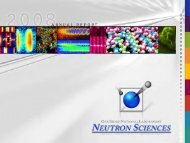ARCS materials - Spallation Neutron Source - Oak Ridge National ...
ARCS materials - Spallation Neutron Source - Oak Ridge National ...
ARCS materials - Spallation Neutron Source - Oak Ridge National ...
Create successful ePaper yourself
Turn your PDF publications into a flip-book with our unique Google optimized e-Paper software.
Magnetic Field (T)<br />
30<br />
25<br />
20<br />
15<br />
10<br />
5<br />
H // [110]<br />
commensurate SDW<br />
incommensurate<br />
SDW<br />
FeGe 2<br />
paramagnetic<br />
0<br />
250 260 270<br />
theory<br />
280 290 300<br />
Temperature (K)<br />
Fig. 3. Magnetic phase diagram for FeGe2 for a magnetic field applied along the [110]<br />
direction determined by resistivity measurements and (for H=0) neutron diffraction.<br />
The line denoted theory corresponds to the approximate phase boundary expected<br />
based on the Ginzburg-Landau theory of Reference [13]<br />
Intensity (mb meV -1 sr -1 )<br />
0.25<br />
0.20<br />
0.15<br />
0.10<br />
0.05<br />
E i =120 meV<br />
∆E=77.5 meV<br />
0.00<br />
1.5 2.0<br />
Q (c*) c<br />
2.5<br />
Fig. 4. Constant energy cut at 77.5 meV through the two counter-propagating spin<br />
wave modes obtained on HET for FeGe2 at 11 K using an incident neutron energy<br />
of 120 meV.<br />
are seen in the inset. The transition temperatures deduced from the resistive<br />
anomalies agree well with those determined by neutron scattering. We have<br />
used similar measurements, together with constant temperature, field scans<br />
which clearly show the lower phase transition, with a magnetic field applied<br />
in the basal plane to determine the magnetic phase diagram for FeGe2, shown<br />
in Figure 3, the behaviour is similar for a field applied along [100].[15]<br />
In order to fully characterise the ground state of FeGe2 we have measured the<br />
spin dynamics at low temperatures (11 K) using the direct geometry timeof-flight<br />
spectrometer HET at ISIS. This instrument allows access to much<br />
higher incident neutron energies than the thermal triple-axis measurements of<br />
Holden et. al.[14] making it possible to fully map out the c-axis dispersion.<br />
Figure 4 shows a constant energy cut through the time-of-flight trajectories of<br />
the 2.5 m detector bank on HET for an energy transfer of 77.5 meV. This was<br />
obtained for an integrated current of 2200 µA-hrs using an incident energy of<br />
120 meV. The two spin wave modes emanating from Qc = 2 are clearly visible,<br />
4

















